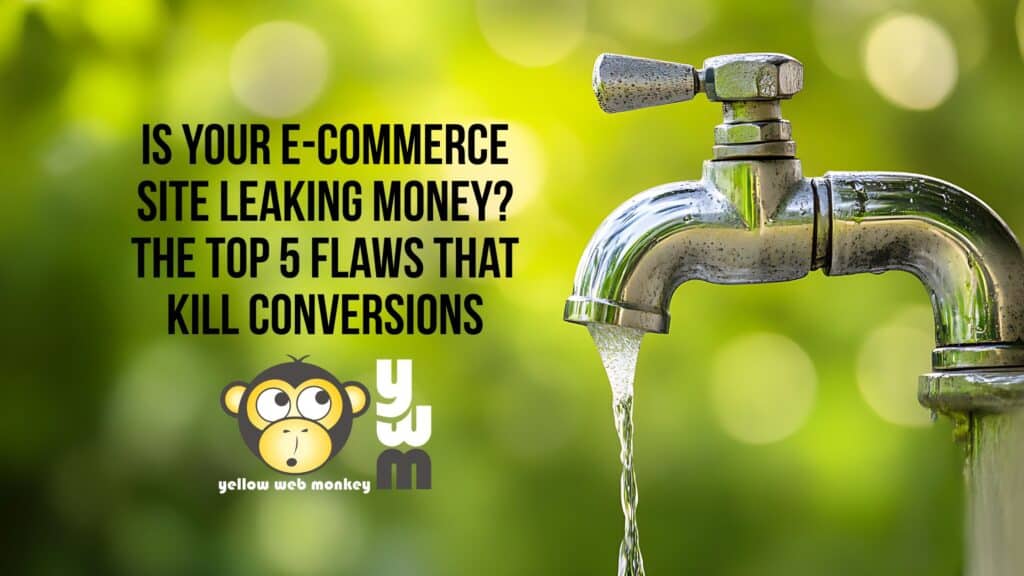You’ve invested in traffic, you’ve optimized your SEO, and your products are so good they practically sell themselves. So why are your sales performing like a leaky faucet? Drip, drip, drip goes your revenue!
The truth is, even the smallest design flaws on your e-commerce site can create invisible leaks, driving away high-intent customers faster than a toddler discovers the snack cupboard. At YellowWebMonkey, a veteran-owned agency, we specialize in building sites with military-grade precision—meaning we don’t tolerate mistakes that cost you revenue (or give us a headache trying to fix them later!).
Here are the top five design flaws we see most often, and how fixing them can boost your bottom line from a trickle to a gush.
1. The Checkout Complication Nightmare
Your checkout is the final hurdle, not an escape room! Yet, many e-commerce sites scare customers off at this critical point, turning eager shoppers into frustrated “nope, I’m out” clickers.
The Leaks:
Forced Registration: “Welcome to our site! Now, before you buy our product, tell us your life story and sign away your firstborn.” Asking a first-time shopper to create an account is a massive barrier. They want to pay and leave, not commit to a long-term relationship.
Hidden Costs: Surprising users with sky-high shipping or tax fees only after they’ve typed in their payment details is like saying, “Surprise! Now cough up another $20!” It’s a quick way to guarantee an abandoned cart.
Too Many Fields: A long, cluttered form feels like work. Every unnecessary field is a chance for a user to just sigh dramatically and bounce.
The Fix:
Implement Guest Checkout as the primary option – because sometimes, one-night stands are best for conversions. Clearly display shipping costs early on. Make the process feel smooth and quick, guiding them effortlessly to that final “Purchase” button.
2. Low-Quality, Scarcity-Killing Photography
In e-commerce, your images are your product. If a customer can’t physically touch or feel an item, the images must do all the heavy lifting. Think of them as your star sales reps – if they look like they just rolled out of bed, they won’t be closing many deals.
The Leaks:
Blurry or Small Photos: If your product image looks like it was taken with a potato, customers will assume your product quality matches. (Spoiler alert: we know yours doesn’t, but perception is reality here!)
Missing Context: Only showing one flat, lonely shot of a magnificent piece of furniture or clothing provides no sense of scale. Is that a dog’s sofa or a human one? We need answers!
No Zoom Functionality: Customers need to inspect seams, fabric texture, and small details before committing to a purchase. Denying them a zoom is like selling a car but keeping the hood glued shut.
The Fix:
Invest in high-resolution, professional photos. Show the product in context (e.g., clothing on a model who looks like a human, furniture in a stylish room) and from multiple angles. Ensure a high-definition zoom feature is standard on every product page – let them scrutinize to their heart’s content!
3. Confusing Calls-to-Action (CTAs)
A well-designed site should act like a helpful guide, clearly telling the user the next step. Conflicting or unclear CTAs are like having ten people shout directions at you at once—you’ll probably just stand still, confused (and slightly annoyed).
The Leaks:
Weak Language: Phrases like “Click Here” or “Submit” are about as exciting as watching paint dry. They’re passive and uninspiring, offering zero motivation.
Invisible Buttons: Low-contrast buttons that blend into the background or are so tiny on mobile devices they require surgical precision to tap. (Are we playing “Where’s Waldo” or shopping?)
Conflicting CTAs: Having “Buy Now,” “Sign Up For Newsletter,” and “Learn More About Our Founder’s Cat” as equally prominent elements on the same screen dilutes the primary goal (which, presumably, is the sale!).
The Fix:
Use high-contrast colors for your primary action buttons (e.g., “Add to Cart”). Use strong, active language like “Checkout Securely,” “Get Your Kit,” or “Shop the Collection.” Ensure the main CTA is the biggest, brightest, most unmissable element on the page—it should be the lighthouse guiding the ship to port.
4. The Mobile Usability Mistake
If your site doesn’t work perfectly on a smartphone, you’re not just losing sales—you’re ignoring the vast majority of the market. And guess what? Google’s mobile-first indexing means poor mobile design directly hurts your SEO rankings. So, yes, it’s a double whammy!
The Leaks:
Tiny Text: Content that requires constant pinching and zooming is immediately abandoned. Your customers shouldn’t need a magnifying glass to read your product descriptions!
Clogged Navigation: Desktop menus jammed onto a mobile screen make finding products feel like a cruel treasure hunt. No one has time for that.
Slow Mobile Load Speed: Mobile users expect pages to load instantly. If it takes longer than a blink, they’re gone. Poof!
The Fix:
Prioritize responsive design from the start. Test every feature on multiple devices – your mom’s old flip phone, your teenager’s iPhone, and everything in between. Ensure navigation uses a clean, accessible hamburger menu and that your product filters and search bar are easy to access with a thumb (because we’re all browsing while juggling coffee, kids, or both).
5. The Scarcity of Trust Signals
Trust is the ultimate currency of e-commerce. If a visitor doesn’t trust your site, they won’t hand over their credit card. It’s like walking into a store with no employees, dusty shelves, and a sign that says “Cash Only, No Refunds!”—you’d probably back away slowly.
The Leaks:
Missing SSL (https): A site without an SSL certificate immediately screams “unsafe” to both customers and search engines. It’s the digital equivalent of a broken lock on your store door.
Lack of Social Proof: No customer reviews, testimonials, or integration with social media platforms. It makes your brand look like it just hatched yesterday, with zero happy customers to back it up.
Vague Shipping/Return Policies: Customers will not buy if they cannot easily find clear, customer-friendly policies on refunds and exchanges. If they can’t trust you to take a return, they won’t trust you with their money.
The Fix:
Display security badges and payment logos (Visa, PayPal, etc.) near the checkout – loud and proud! Feature product reviews prominently (the good ones, of course!). Ensure your shipping and return policy is clearly explained on the product page. This integrity is something we build into every one of our veteran-designed websites, because trust isn’t optional – it’s foundational.
Final Thoughts: Fixing the Leaks for Good
Stopping those revenue leaks requires both deep technical knowledge and a commitment to transparent service. As a veteran-owned agency and certified Shopify Partner, YellowWebMonkey focuses on building and optimizing e-commerce sites that are inherently stable, trustworthy, and conversion-ready. We believe in precision, not quick fixes.
If you’d like an expert, veteran-led team to review your current setup, we’re always available for a straightforward, no-pressure consultation.





